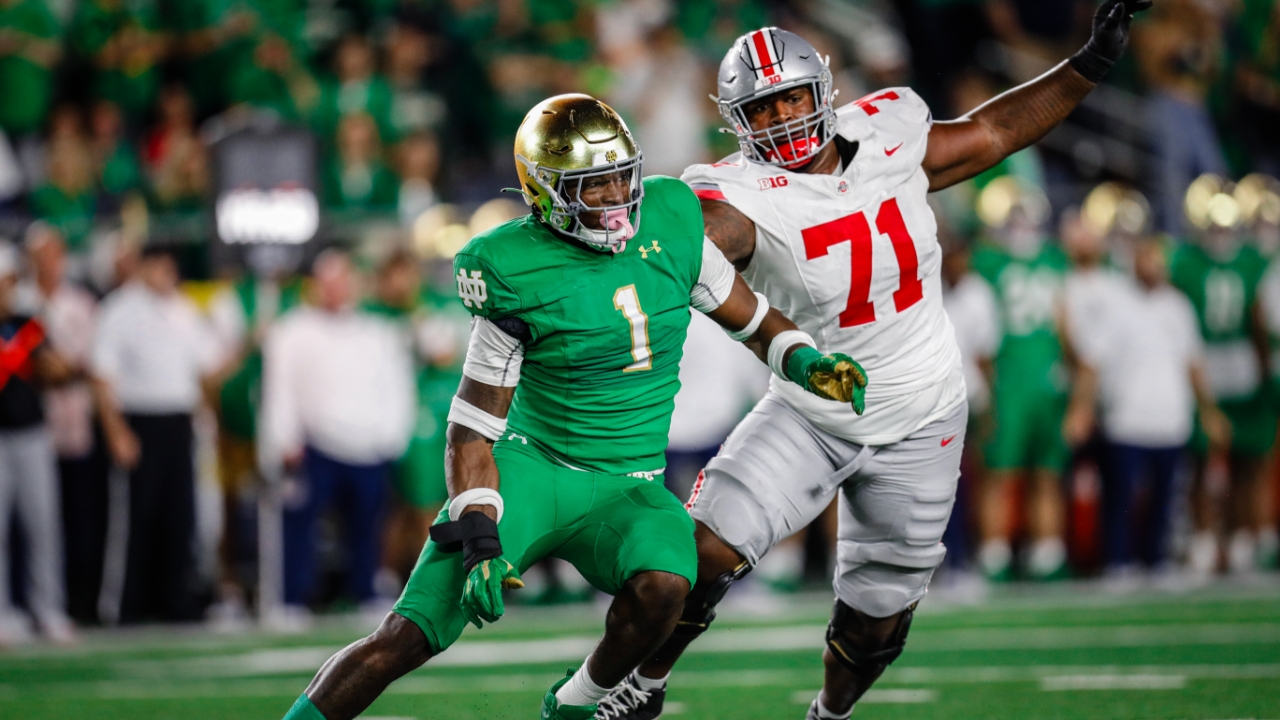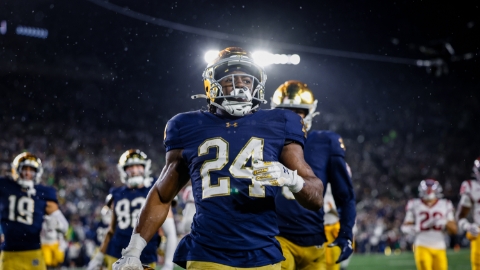
Florida State was a legitimate national championship contender last season. They had the record that should have earned them an opportunity to play in the College Football Playoff and they had the roster to compete with the best teams in the country.
That roster was largely built through the transfer portal, FSU had 10 players selected in the most recent NFL Draft. Nine of them started out at different programs. That includes five who were drafted on day one or day two (first three rounds) of the draft.
Head coach Mike Norvell proved that a contender can be built through “free agency”. That doesn’t mean others should try, though. It’s what Lincoln Riley attempted to do at USC and he experienced the volatility of the process.
The Trojans hit home runs with QB Caleb Williams, WR Jordan Addison, CB Mekhi Blackmon, and RB Marshawn Lloyd. They whiffed on Mario Williams and Dorian Singer at receiver and numerous others on defense.
Transfers have been impacting college football for decades, but the explosion of transfers in the last few years with the implementation of the one-time transfer rule changed things drastically. Add in an extra year of eligibility for players because of the shortened 2020 season and it’s allowed roster makeovers to happen quickly during an offseason.
While Deion Sanders may have gotten most of the attention for his ruthless approach at Colorado, it hasn’t gone unnoticed that adding 20 or more transfers from December to May isn’t seen as abnormal. Ole Miss added 47 total transfers and Louisville added 56 in the last two offseasons and no one batted an eye.
There’s still so much we have to learn about the scouting process with transfers. We don’t have enough years of data to say one team has consistently done better than others and we don’t know what will change in the next few years. All we can do is take the date we have and see what we can learn from it.
What positions have produced the most talent in the transfer portal
There were 113 position players selected in the last two NFL Drafts who transferred schools during their college careers (not including quarterbacks or specialists). Out of that 113, here’s how the positions broke down in terms of picks:
25 WR
18 CB
16 Edge
10 DT
9 iOL (guards or centers)
7 LB
6 OT
5 TE
4 safety
40 of the 113 were taken on day one or day two of the draft. Here’s how that broke down by position:
9 WR
7 Edge
5 CB
4 RB
4 DT
3 iOL
3 OT
3 LB
1 TE
1 S
The biggest thing that stands out is that over 50% of the overall picks who were transfers and over 50% of the picks who were selected in the first three rounds come from three positions: wide receiver, edge defenders, and cornerbacks.
From an overall perspective, I think it’s fair to say that the odds of landing impact talent at those positions is better than any of the others. The sample size isn’t big enough to indicate that this is going to continue to be the case, but that’s how it’s been so far.
From a Notre Dame perspective, this is a good thing based on who they’ve added as transfers in 2024. They brought in Kris Mitchell, Beaux Collins, and Jayden Harrison at receiver, RJ Oben as an edge, and Jordan Clark as a slot corner/nickel. This is after finding success with Javontae Jean-Baptiste (seventh round pick) and Thomas Harper in the previous transfer cycle.
Notre Dame may not need to go heavy into any of these three positions in the next transfer cycle if they like the development of their young talent at receiver, edge rusher, and corner, but if they do, there should be options available.
Offensive tackle and tight end jump out as positions who didn’t produce as much NFL-level talent. With tight end, that’s probably partially because of how much the position is valued by the NFL as a whole. And with Notre Dame’s track record at the position, recruiting elite high school tight ends is not going to be a problem.
With offensive tackle, it’s clearly a question of not being able to find top tier transfers because everyone knows how much the position is valued by everyone in football. Seven tackles went in the first round this spring, tied with wide receivers for the most by any position.
Many Irish fans were hoping that Notre Dame would grab an offensive tackle in the portal after losing Joe Alt and Blake Fisher to the NFL, but there were unsurprisingly a lack of options who would have been better than what Notre Dame already has on their roster.
The offensive tackles could take some lumps early in the season against Texas A&M with their talented pass rushers, but developing young players like Charles Jagusah, Aamil Wagner, Anthonie Knapp, and Guerby Lambert is a better move for the entirety of the 2024 season and beyond. And if Joe Rudolph continues to land blue-chips like Will Black and Matty Augustine,
Notre Dame will be just fine moving forward at the position.
Identifying smaller school gems
Out of the 113 transfers who were drafted, 35 (31%) started out at programs that were in the Group of 5 in the FBS or were from lower levels in the NCAA. From that 35, here were the top-four position groups drafted:
7 WR
6 Edge
5 CB
5 iOL
It pretty much adds to what we saw from all the transfers. However, it is noteworthy to me that only 11 of those 31 were taken on day one or day two and it’s led by classic late-bloomers like Utah TE Dalton Kincaid, Florida State edge Jared Verse, and Georgia Tech edge Keion White.
Those guys weren’t just under the radar. They were basically in the Bermuda Triangle as recruits and had gigantic leaps in development.
DT Chris Smith was a solid addition as a rotation player after transferring from the Ivy League to Notre Dame in 2022. They missed with Antonio Carter who made the jump from the FCS last year. We can go back to Alohi Gilman (Navy) to see how well it does work out when there is a hit.
Mitchell (FIU) and Harrison (Marshall, but started out at Vanderbilt) are the two Group of 5 transfers they added this year. We’ll see if Mitchell can see his success translate at Notre Dame like it did for Tez Walker at North Carolina (Kent State), Jamari Thrash at Louisville (Georgia State), or Jacob Cowing at Arizona (UTEP) after they moved up to play better competition.
These players have college film to evaluate, but it’s always an inexact science trying to project players when they are going to play at a higher level. One thing that helps is knowing if they have speed that will translate. With Harrison, there are GPS numbers from him returning kicks like this touchdown against James Madison.
There’s also the fact that he recorded a 37.4 inch vertical as a recruit, was a member of a state champion 4 x 100 team, and if that’s not enough, they can verify with NFL scouts or coaches they may have relationships with to see if that reported 4.4 at Marshall is legitimate.
Mitchell ran a 10.92 100 and 21.99 200 in high school. Those translate above the 75th percentile for wide receiver recruits. They’ve also seen him run away from defenders when playing a Power 5 program like Arkansas last season.
It can be a lot more difficult to project other positions from lower level programs without a lot of information from NFL people who may have intel on them. It’s why having relationships with those scouts can prove to be very helpful when evaluating potential transfer targets.
“Trust your own eyes”
JJB was a tremendous pickup for Notre Dame last year. The biggest reason the staff could have confidence that he would be more than the situational pass rusher he was at Ohio State was what Al Washington and Nick Sebastian knew him from when they worked in Columbus.
The relationship might have been what sealed the deal in terms of landing him. Seeing him in the program for years is what made it an easy evaluation.
Notre Dame identified Thomas Harper as a fit at nickel for them and it was a move that didn’t produce much fanfare at the time. I don’t know for a fact that the process in identifying him as a player they liked started in preparation for their Fiesta Bowl matchup with Oklahoma State, but it would have been an obvious introduction to his game in preparation for that game.
It’s not a coincidence that Riley Leonard, RJ Oben, and Beaux Collins became priority targets for Notre Dame because Notre Dame played both Duke and Clemson last season. They had Clemson on the schedule in 2022 as well, so they would have seen a lot from Collins to give them confidence he can help out the Irish as a boundary receiver in 2024.
When the staff spends countless hours preparing for an opponent, they get to know the personnel they are facing very well. It only makes sense to use that information when assessing potential transfers.
Though no one from Notre Dame was watching much Northwestern film before studying Rod Heard II’s game, Marcus Freeman was very familiar with Heard as a player and person when he recruited Heard to play at Cincinnati. There’s no doubt that that assisted in the process when evaluating Heard’s fit at Notre Dame.
With the way the roster is constructed right now, it makes sense for Notre Dame to not add anywhere close to the eight transfers they’ve added this recent offseason. They will likely add at least a few transfers after this season, though, and no one should be surprised if some of their targets will be playing against Notre Dame this fall.
Men's '47 Green Notre Dame Fighting Irish Clean Up Adjustable Hat


